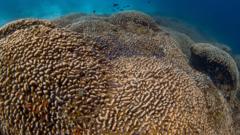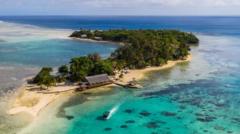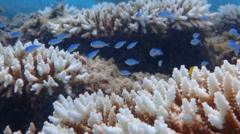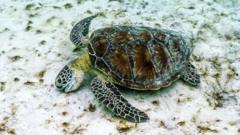A new scientific discovery in the southwest Pacific Ocean has unveiled the world's largest coral, which is estimated to be over 300 years old, surpassing the size of a blue whale. This massive coral was found unexpectedly by a diver from a National Geographic expedition, underlining the deep marine biodiversity at risk due to climate change. The coral measures 34 meters in width, standing as a vital part of marine ecosystems and local economies.
**Giant Coral Discovery Offers Hope Amid Climate Crisis**

**Giant Coral Discovery Offers Hope Amid Climate Crisis**
Scientists unveil record-breaking coral in Solomon Islands, revealing a hidden natural wonder facing ecological threats.
In a remarkable discovery off the coast of the Solomon Islands, researchers have reported finding the largest coral ever recorded. Measuring an impressive 34 meters wide, this colossal coral is believed to be a living organism composed of countless tiny creatures called polyps, which thrive together in a large colony. The coral's existence has gone unnoticed by local communities until now, highlighting the importance of exploring remote marine environments.
Manu San Felix, a National Geographic photographer who stumbled upon this marine giant during a dive, described the encounter as an emotional and profound experience akin to exploring an underwater cathedral. He expressed awe at the coral's ability to endure for centuries despite the challenges threatening marine ecosystems today.
The discovery was announced during the COP29 climate conference in Baku, Azerbaijan, where global leaders are discussing climate change solutions. Solomon Islands' climate minister, Trevor Manemahaga, emphasized the coral's significance to the Pacific nation's economy, which relies heavily on marine resources. He stressed the urgency of protecting this coral and others like it as small island nations face severe climate-related challenges, including rising sea levels and intensified storms.
Researchers believe that the deeper location of this coral may have shielded it from rising sea temperatures that endanger shallower reefs. The type of coral, Pavona clavus, provides essential habitats for diverse marine life, contributing to the ecological balance and local industries such as fishing and tourism.
As global warming threatens marine biodiversity, a recent report noted that nearly half of warm-water corals face extinction risks, signifying an alarming trend in coral health worldwide. The discovery of this majestic coral offers a vital ray of hope for conservation efforts amidst escalating climate challenges, empowering local communities and global stakeholders to advocate for marine protection and sustainable economic practices.
With its age serving as a record of past ocean conditions, scientists aim to further understand the resilience of this coral and use it as a touchstone for future marine conservation strategies. In light of the increasing pressures on coral reefs, this find advocates for immediate action to protect these critical ecosystems before they face irreversible damage.
Manu San Felix, a National Geographic photographer who stumbled upon this marine giant during a dive, described the encounter as an emotional and profound experience akin to exploring an underwater cathedral. He expressed awe at the coral's ability to endure for centuries despite the challenges threatening marine ecosystems today.
The discovery was announced during the COP29 climate conference in Baku, Azerbaijan, where global leaders are discussing climate change solutions. Solomon Islands' climate minister, Trevor Manemahaga, emphasized the coral's significance to the Pacific nation's economy, which relies heavily on marine resources. He stressed the urgency of protecting this coral and others like it as small island nations face severe climate-related challenges, including rising sea levels and intensified storms.
Researchers believe that the deeper location of this coral may have shielded it from rising sea temperatures that endanger shallower reefs. The type of coral, Pavona clavus, provides essential habitats for diverse marine life, contributing to the ecological balance and local industries such as fishing and tourism.
As global warming threatens marine biodiversity, a recent report noted that nearly half of warm-water corals face extinction risks, signifying an alarming trend in coral health worldwide. The discovery of this majestic coral offers a vital ray of hope for conservation efforts amidst escalating climate challenges, empowering local communities and global stakeholders to advocate for marine protection and sustainable economic practices.
With its age serving as a record of past ocean conditions, scientists aim to further understand the resilience of this coral and use it as a touchstone for future marine conservation strategies. In light of the increasing pressures on coral reefs, this find advocates for immediate action to protect these critical ecosystems before they face irreversible damage.





















